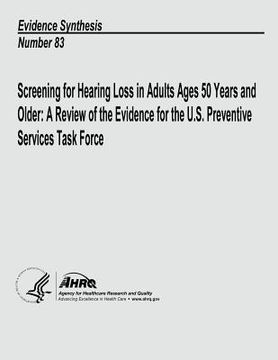Compartir
Screening for Hearing Loss in Adults Ages 50 Years and Older: A Review of the Evidence for the U.S. Preventive Services Task Force: Evidence Synthesis (en Inglés)
U. S. Department of Heal Human Services
(Autor)
·
Agency for Healthcare Resea And Quality
(Autor)
·
Createspace Independent Publishing Platform
· Tapa Blanda
Screening for Hearing Loss in Adults Ages 50 Years and Older: A Review of the Evidence for the U.S. Preventive Services Task Force: Evidence Synthesis (en Inglés) - And Quality, Agency for Healthcare Resea ; Human Services, U. S. Department of Heal
$ 39.901
$ 66.502
Ahorras: $ 26.601
Elige la lista en la que quieres agregar tu producto o crea una nueva lista
✓ Producto agregado correctamente a la lista de deseos.
Ir a Mis Listas
Origen: Estados Unidos
(Costos de importación incluídos en el precio)
Se enviará desde nuestra bodega entre el
Martes 27 de Agosto y el
Jueves 05 de Septiembre.
Lo recibirás en cualquier lugar de Argentina entre 1 y 3 días hábiles luego del envío.
Reseña del libro "Screening for Hearing Loss in Adults Ages 50 Years and Older: A Review of the Evidence for the U.S. Preventive Services Task Force: Evidence Synthesis (en Inglés)"
Hearing loss is common in older adults, increases in prevalence and severity with age, and can affect quality of life and ability to function. The U.S. Preventive Services Task Force (USPSTF) issued a recommendation on screening for hearing loss in adults ages 50 years and older in 1996. In 2009, the USPSTF commissioned a new evidence review in order to update its recommendation. The purpose of this report is to systematically evaluate the current evidence on screening for hearing loss in adults ages 50 years and older in primary care settings. A person with normal hearing perceives sounds at frequencies between 20 and 20,000 Hz. Frequencies between 500 and 4000 Hz are most important for speech processing. There is often discordance between objectively measured deficits in tonal perception at specific frequencies and intensity levels (measured as decibels) and subjective perceptions of hearing problems. One study found that 20 percent of persons reporting hearing difficulty had normal hearing tests, while 6.2 percent of those not reporting difficulty had significant hearing loss. Hearing problems despite normal hearing tests could be caused by abnormal signal processing or sound discrimination. Because treatments for hearing loss are targeted at improving tonal perception by signal amplification, we use the term "hearing loss" in this review to refer specifically to deficits found on objective testing. The standard objective test for hearing loss is the pure-tone audiogram, in which a patient is placed in a soundproof booth and tested on ability to hear tones at a series of discrete frequencies, typically in the range of 125 to 8000 Hz, at various decibels. There is no universally accepted definition for hearing loss. Reference criteria vary with regard to the frequencies and intensity thresholds used to determine hearing loss, and whether one or both ears are affected. Many studies define mild hearing loss as inability to hear frequencies associated with speech processing less than 25 dB and moderate hearing loss as inability to hear those frequencies less than 40 dB. Commonly used reference criteria include the Ventry and Weinstein criteria (greater than 40 dB hearing loss at either 1000 or 2000 Hz in both ears, or greater than 40 dB hearing loss at 1000 and 2000 Hz in one ear), the speech frequency pure-tone average (SFPTA) criteria (greater than 25 dB average hearing loss at 500, 1000, and 2000 Hz in the better ear), and the high-frequency pure-tone average (HFPTA) criteria (greater than 25 dB average hearing loss at 1000, 2000, and 4000 Hz in the better ear). Key Questions presented in this report include: Key Question 1: Does Screening for Hearing Loss in Asymptomatic Adults Ages 50 Years and Older Lead To Improved Health Outcomes? Key Question 2: How Accurate Are the Methods for Screening for Hearing Loss in Older Adults? Key Question 3: How Efficacious Is the Treatment of Screening-Detected Hearing Loss in Improving Health Outcomes? Key Question 4: What Are the Adverse Effects of Screening for Hearing Loss in Adults Ages 50 Years and Older? Key Question 5: What Are the Adverse Effects of Treatment of Screening-Detected Hearing Loss in Adults Ages 50 Years and Older?

